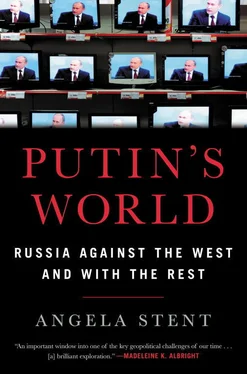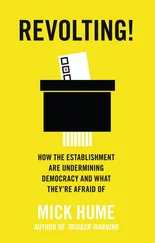Russian state-run media praised the summit as the first step toward improving ties. 72US media was much more divided, with former CIA head John Brennan accusing Trump of treason. 73In the days following the summit, the Kremlin floated two ideas that it claimed also had been discussed in Helsinki: holding a referendum in the Donbas to decide the region’s future and having Mueller come to Russia to sit in on interviews with the twelve indicted GRU agents in return for Russian criminal police interrogating former US officials and businessmen connected to the Magnitsky Act list. 74Both ideas were soon rejected—but it took the White House several days to criticize the latter.
Helsinki was a win for Putin, a significant achievement in Putin’s world. After eighteen years in power, he had achieved what he wanted from the United States and what he believed he had not had since his first summit with Bush in Slovenia in 2001: respect and equality. The US president had praised him while publicly criticizing his own officials. Days after Trump returned, he invited Putin to visit Washington. The domestic battle between Trump partisans and opponents intensified in the aftermath of the summit, further polarizing the Russia issue. Some Russians questioned whether Putin would regret having waded into the toxic domestic debate by coming down so firmly on Trump’s side. 75After Helsinki, the disconnect between the president and his key colleagues in their evaluation of Russia continued. But by beginning to restore relations, there was a chance that US and Russian officials would start to work more intensively on the long list of problems that require their urgent attention.
THE AGENDA FOR US-RUSSIA RELATIONS IN PUTIN’S FOURTH TERM
Irrespective of where the Russia investigation goes, there are a number of pressing points in the US-Russia relationship. The US-Russia agenda focuses on a few multilateral issues in which the interests of both sides necessitate engagement because of ongoing conflicts. The first is Syria. The air forces of both countries are present in Syria, and coordinating air operations remains important. The Russians are trying to secure promises of US assistance in reconstructing Syria, and the US wants Russia to rein in Iran’s activities there. Syria is also an area where counterterrorism cooperation could be deepened, although so far that has proven elusive.
Ukraine is another priority. The US-Russia channel led by Kurt Volker and Vladislav Surkov was supposed to achieve progress on resolving the crisis, but so far the pace of negotiations remains glacial. Putin’s suggestion of holding a referendum in the Donbas is a nonstarter as long as Russian troops remain there, and neither side appears interested in fully implementing the Minsk II agreements. Something could change after the Ukrainian elections in 2019, but there appears to be little incentive for ending the ongoing hostilities.
North Korea is another potential area for cooperation. Russia supported tougher UN sanctions on the North Korean regime, but there was also evidence it was increasing its economic ties to the north, as China was cutting back on its trade. There are also substantial numbers of North Korean laborers working in the Russian Far East under very harsh conditions, and Russia refused to repatriate them, as was required by the UN sanctions. 76So far, Russia has remained a side player in trying to resolve the North Korean denuclearization problem, but Putin hopes to play a greater role going forward.
The most important bilateral US-Russia issue is the state of both countries’ nuclear arsenals and the looming expiration or jettisoning of two treaties that for almost half a century have created a predictable and stable arms control regime since Richard Nixon and Leonid Brezhnev signed the Strategic Arms Limitation Treaty (SALT) in 1972: the Intermediate Nuclear Forces (INF) Treaty, signed in 1987, and the New START, signed in 2011. The New START committed each side to reducing its stockpiles of strategic nuclear weapons, and in February 2018, both sides announced they had in fact complied with the provisions. 77But the US and Russia both maintain some four thousand nuclear weapons—more than ten times the number of any other country. 78Moreover, both the US and Russia are committed to modernizing their nuclear forces and developing new, more powerful weapons systems. Putin made this clear in his pre-election speech, and Trump has also said, “We must modernize and rebuild our nuclear arsenal.” 79Russia has communicated that it does not want any further reduction in strategic nuclear weapons. So far, attempts at negotiating what comes after New START, which expires in 2021, have not been successful in a time of heightened US-Russia tensions. The treaty could be prolonged for another five years by presidential decree, and this may be the most realistic path to ensure that a strategic arms control regime is preserved. However, a five-year prolongation would at best represent a holding pattern. What is needed going forward is a new framework taking into account emerging technologies, such as enhanced cyber capabilities, outer space, artificial intelligence, and missile defense. If there is no new treaty, the US and Russia will enter into a new, unpredictable, and dangerous nuclear, cyber, and outer space arms race.
The other treaty at risk is the INF Treaty, which committed both sides to eliminate a whole class of intermediate-range weapons. The US claims that Russia has violated this treaty by deploying an intermediate-range ground-launched cruise missile. Russia denies this and argues that the US has violated the treaty by building missile-defense sites in Romania and Poland capable of launching intermediate-range cruise missiles. The INF Treaty is in danger of collapsing unless the two sides can negotiate seriously about how to preserve it. In October 2018 National Security Adviser John Bolton met with Putin in Moscow and told him that the United States intends to withdraw from the INF Treaty, a move that drew widespread criticism in Russia, Europe, and the United States. The imperative to tackle these challenges is compelling because of the dangers of nuclear proliferation. If the US and Russia—which control 90 percent of the world’s nuclear weapons—are no longer constrained by arms control agreements, how will that affect the effort to prevent other states from acquiring nuclear weapons? 80
There are some areas where the United States and Russia continue to cooperate. One of them is space. The US depends on Russian capsules to transport US astronauts to and from space and to launch its satellites. Russia makes money from its space cooperation with the United States, and its cosmonauts have developed productive relations with their American counterparts. Additionally, the Boeing Company has had a close relationship with Russia for decades. Without Russian titanium, it could not build its planes, and it works closely with Russian engineers to design them. The Russian company TMK produces pipes used in the exploration and production of US shale oil. 81In compartmented public and private spheres, where specialists can work together in an environment largely removed from the political cauldron, America and Russia can cooperate effectively. 82
Another area of cooperation could be cybersecurity. Ultimately Washington and Moscow should sit down and discuss cyber rules of the road going forward. There are precedents for this. The US and China have a commercial cybersecurity agreement on economic espionage that works reasonably well, despite their very different views of the cyber arena. 83Moscow has several times proposed opening talks on cybersecurity—most recently in Helsinki—but so far these feelers have been rebuffed because of US doubts about whether Russia would adhere to any new agreement given the continuing Russian interference in US cyberspace, which the Russians continually deny. The fundamental issue, of course, is the absence of trust between the leadership of both countries, which hampers any meaningful engagement in this area. A prerequisite for achieving agreement on a cyber code of conduct would be to begin with small confidence-building measures, but these so far remain elusive.
Читать дальше












